

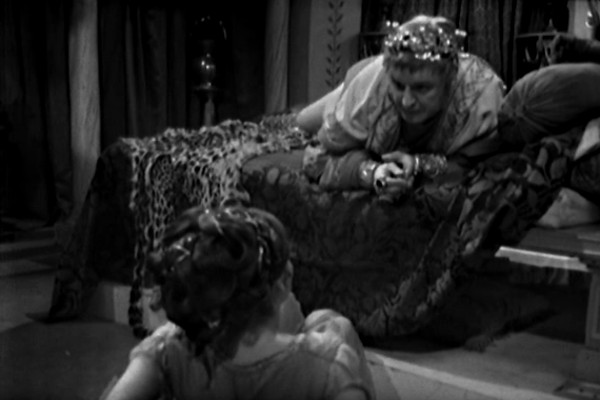
The subject of rape is a surprisingly frequent one in Hartnell's Doctor Who. It occurs, largely offscreen, in The Time Meddler, where its effects on the victim are felt. There's also Barbara being illicitly sought after by a jail guard in The Reign of Terror and, with more menace, a hunter in The Keys of Marinus. But only The Romans uses the threat of rape for full-on comic effect.
It's perhaps overstating it here, as Nero only asks Barbara for a "kiss" in the family timeslot, and it is, for the subject matter, almost "innocent", certainly more Carry On/Bedroom Farce than Straw Dogs. But it sits badly in the modern age and acts as a reminder that while Barbara is a surprisingly progressive role for the time, what was deemed acceptable in the 60s is still very different to that of today.
Yet while retrospective articles such as these often look back on how the serials seem to modern eyes, such views are, almost by definition, irrelevant. This serial was made for the population of 1965 to watch, and it's the viewer's choice, over half a century later, to buy the DVD and watch what is, after all, an historical document in more senses than one.
The word "charm" is used frequently in this article, almost by accident, as it's the one word that comes to mind when watching these stories. The Romans has charm, no doubt, but watched in context of the series it can be too silly; the frail grandfather figure of Hartnell is flipping men over in fist fights, and the Barbara situation stands up very badly in the modern age. Yet Hartnell becoming the more central figure and a more physically active one was clearly being implemented; in season one a shovel-bashing was his only violent act... from The Dalek Invasion of Earth onwards, every season two story sees him involved in some form of physical conflict.
Despite all this, if The Romans is watched with a light frame of mind, it can really reward. With the crew having stayed in Rome for "nearly a month" as the story opens, it's a rare chance to see an offbeat, "TARDIS crew on holiday" adventure. We also learn that the TARDIS isn't damaged from a great fall (neither are its occupants) and that it can take off from any angle.
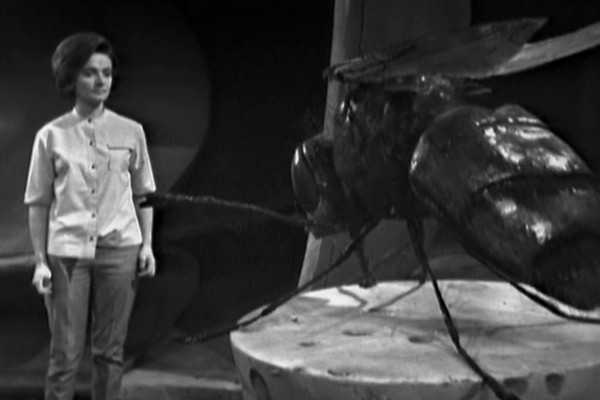
Planet of Giants marked the debut of Dudley Simpson, Doctor Who's most prolific composter, who scored 62 stories from 1964-1980. Altogether he scored over three quarters of the Jon Pertwee and Tom Baker stories, along with over a third of Patrick Troughton's.
While the Tom Baker era is also a huge favourite here at the Anorak Zone, it has to be said that Simpson's work, as ubiquitous as it was, wasn't the ideal fit for the show. He was capable of some memorable and melodic tunes (City of Death) and some distorted electronic scores (Fury From The Deep), but often his work was orchestral, with events on screen punctuated by cymbal crashes and the like.
Simpson went on to score the Hartnell stories The Crusade, The Chase and The Celestial Toymaker, and while his work was sometimes pretty good, it was the stranger, electronic and more experimental scores of the 60s that stick in the mind. The best soundtracks came from the principles of the avant-garde, as opposed to the principles of the theatre pit.
Planet of Giants is swamped by its incidental music, often at odds with what's on screen, distancing the viewer. Containing a nice ecology subtext, it is, sadly, one of the more rudimentary of scripts for the period, seeing characters telling each other chunks of exposition, while, when shrunk, the intelligence of all the regulars is reduced even further than their height.
Despite all this, it has its charms - there's that word again - and the ambition of the show on a very limited budget has to be commended. Some of it doesn't stand up as well on the higher definition of DVD, where, for example, wires on the moving fly can be seen, but it all gets by. The big trivia story behind this is that the concept behind Planet of Giants was originally planned as the very first adventure instead of An Unearthly Child... probably for the best that it was delayed in production, as it pushes the serial more towards the science fantasy that it was known for in the entertaining but less "real" 70s.
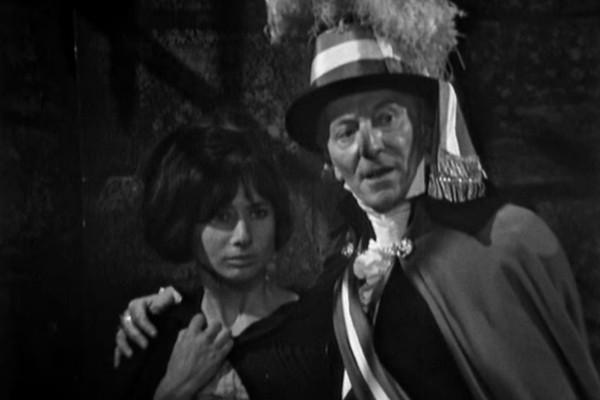
There is a small section of fandom that's cool towards the 1960s era due to the black and white filmstock, believing the look to be inferior to the colour years, and even some that dedicate time towards "colourising" the frames. While the results are usually impressive, it's strange that what can be regarded as the more artistic medium is frowned upon.
Yet away from the shadows and noir that the SF stories can provide, one way in which colour perhaps would be appreciated is with the historicals. Set photography has produced many images from the filming of these serials, most of them wonderful to look at. The Reign of Terror also marks the first time that (very brief) outdoor location filming was used for the series.
The Reign of Terror was the first script for the series by Dennis Spooner, a writer who became script-editor from The Rescue to The Chase, and went on to write The Romans, The Time Meddler, The Daleks' Master Plan (with Terry Nation) and, uncredited, worked on the Patrick Troughton story The Power of the Daleks.
Spooner is probably most famous for his later work with ITC, including co-creating Randall and Hopkirk (Deceased). His most significant contribution for Doctor Who was introducing humour to the programme, and, for better or worse, The Reign of Terror is notably lighter than the seven stories that came before it. Some of the scenes can be amusing, but the jaunty, upbeat music from Stanley Myers overeggs each "joke". Myers was a good composer, most known for the theme from The Deer Hunter, but his work here is not his finest.
In terms of trivia, Doctor Who is a series that's the product of many different writers, directors and producers. As a result it's only natural that it will contradict itself, but the first real continuity issue occurs with this story... possibly. The very first episode had featured Susan reading a book on the French Revolution and proclaiming "but that's not right." Here they take part in the French Revolution, though, as she tells Ian and Barbara that it's one of her grandfather's favourite parts of history, maybe they'd been there before, and avoided bumping into themselves?
Lastly, several missing Doctor Who episodes have been animated for DVD releases, most notably partially-missing Patrick Troughton stories. The animations are generally produced on a tight budget, but do their job reasonably well, depending on personal taste. Here at The Anorak Zone, a reconstruction using still "telesnap" images is preferred, though it's understandable why this isn't regarded as viable for a DVD release. (Galaxy 4 had the reconstruction treatment, but was presented as an "extra" on a reworking of The Aztecs, not a release in itself).
However, the animation used for The Reign of Terror is not only slightly eerie in movement, but is not sympathetic to the material it's representing. The Reign of Terror, like most of the era, was shot in very long takes with minimal resources. The cartoon version can scarcely go for five seconds without changing shots, including extreme close-ups which would not have appeared in the serial itself. It detracts, rather than enhances, the material, and makes a jarring companion to the existing episodes on the same disc.
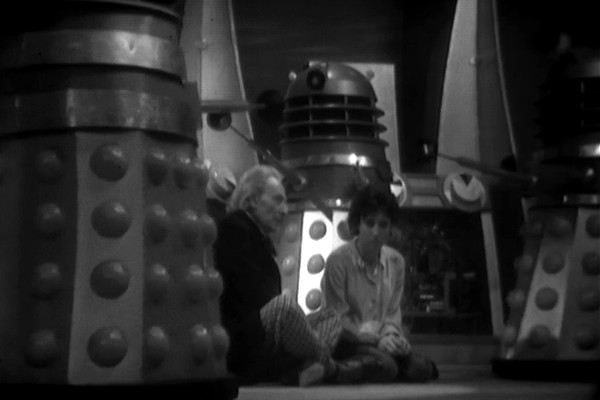
The Daleks is split between one of the very best and one of the very worst of the 60s directors: Christopher Barry and Richard Martin. However, for once it makes very little difference who's running events behind the camera, as both generate a story that can look a little staid and clunky, not helped by a typically stiff Terry Nation script and Hartnell off his game, frequently behind the script.
The importance of this one cannot be overestimated, as it transformed the show from a moderate success into a colossal part of Saturday night, with schoolchildren up and down the country imitating the series' most famous villains. An unsubtle yet brilliant Nazi allegory, they're so potent a creation that they were brought back regularly for the new version of the series, even though their metaphorical relevance had long since passed into history, rendering them meaningless as a subtext.
At seven episodes, the serial is overlong by at least one instalment, and a great deal of the dialogue given to the Thals is trite. However, the Daleks are developed characters here, not catchphrases on castors, and the geography of their city is well realised on a small budget, with a real sense of scale. Most importantly of all is Tristram Cary‘s doom-laden electronic score, which is, as mentioned elsewhere, first rate.
For trivia, then the entire first episode was rerecorded. This wasn't the same as the first episode of An Unearthly Child, which was rerecorded as it was deemed to lack sufficient quality... here a technical fault led to bleed through of control sound throughout. A clip of the episode makes up the episode two opening reprise, though the rest of the original version has long since been destroyed.
Lastly, it's notable that almost everything was first tried out in the Hartnell era, a run of stories that, generally, manages to keep a sense of cohesion despite being wildly different in form and genre. The idea of being able to hear the thoughts of characters is an unusual one, and featured, briefly, in a very small number of stories (The Underwater Menace, The War Games and Mawydryn Undead). However, even that innovation was started here, as the playback of audio allows Susan to hear Ian's words of advice in her head at the end of episode two.
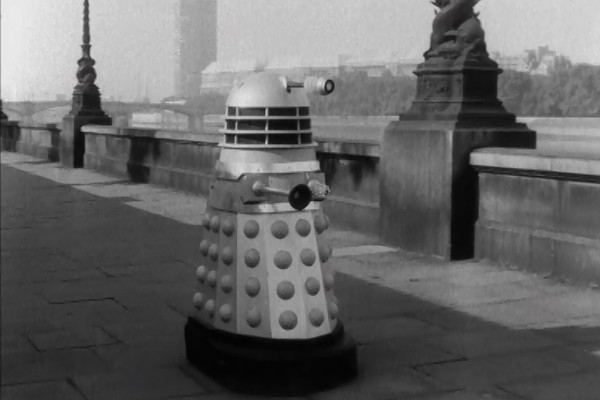
The Dalek Invasion of Earth is hugely ambitious, including major location filming, and is faster-paced and more tightly edited than what came before. Despite the even clearer Nazi parallels, it's pulp nonsense in many ways, and the humanised Dalek voices are pretty awful, but it's entertaining pulp nonsense.
The first three episodes are genuinely quite good, and the finale, with Susan leaving, is a standout. But the second half of the story sees the programme fully become the "kid's show" it's often derided as. The Slyther is the first of the show's truly silly monsters, and Barbara and the Doctor doing "convincing" Dalek voices shows how poor the ring modulation was in this one. The DVD contains an optional feature to watch the story with new CGI saucer effects, seemingly there as a sop to people who can't accept that TV was once made in 1964 on a restricted budget.
The story is Susan's last, though Carole Ann Ford would return, alongside Richard Hurndall as the first Doctor, in the 1983 story The Five Doctors, and by herself ten years later for a Eastenders 3D charity crossover Dimensions In Time.
Doctor Who was so popular during its first two seasons that a three-movie deal was licensed, with Peter Cushing playing the part of "Dr. Who", an Earth inventor. The first film, based on The Daleks, came to cinemas during the gap between seasons one and two; Daleks' Invasion Earth: 2150 A.D. was released in a gap between The War Machines and The Smugglers, a time when Doctor Who was a lot less popular, not even ranking in the top 60 most-watched programmes of the week. Perhaps not unexpectedly, it underperformed at the box office, causing the third film in the series to never be made.
With a budget around 12 times greater than that of its TV inspiration, it shows on screen, and the film is fast-paced and kind of fun, if you're really in the mood. Made for a far younger audience in garish Technicolor, it extracts the depth of the original, but this is to be expected given that the characters and events are only based on the TV serial, and that Susan in the movies is just 12 years old.
Mention has been made elsewhere about the decision to recast the first Doctor as David Bradley in 2017 and have him be horribly out of character. Yet even more puzzling was the decision to have him repeat his threat of a "smacked bottom" to the Doctor's then-latest companion, as if the first Doctor was a sadist or pervert... whereas when he threatens it in the first episode of this story it's not to a random female, but to his own granddaughter.
While spanking children is largely frowned upon today, and illegal in most cases, it was a norm at the time, over half a century ago, and so the decision to revisit this, but take it completely out of context, is either a misunderstanding of social history or a deliberate misunderstanding in the name of a cheap laugh. It was an appalling attempt from the new series to, yet again, promote its own sense of self-referential knowingness by attacking its own, irony-free past.
Speaking of the new version of Doctor Who, then the same serial brought a female Doctor to the screens. Such an event has sparked many battles over social media, with Twitter, in particular, seeing many cross words (even between actors who have played the Doctor) where such things are a black and white polemic. The notion of the Doctor changing gender after 55 years is a little more complicated than that, with many levels and grey areas to consider, but in regards the Hartnell era, Susan finishes this story by marrying David Campbell... If Time Lords really can change gender, you'd have to hope that Campbell is very open-minded...
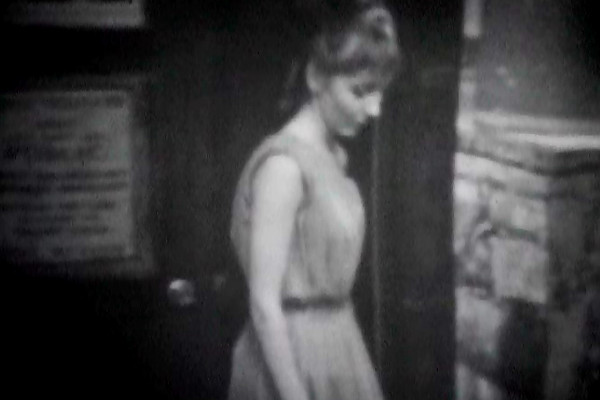
The Myth Makers is a completely missing story, and consequently it becomes more difficult to rank. While tales like The Reign of Terror have more than half their run in existence, meaning you can get a good idea of what the whole of it would look like, the completely missing stories are another matter entirely. Is it even possible to successfully rank something you've only heard against pieces of television you've seen? As with The Savages, the only known footage to date is 8mm footage recorded off screen by fans, once again explaining the poorer quality of the screen capture above.
The Myth Makers is a witty and literate tale, but does suffer badly from a lack of photographic material and only scant clips available. Some stories have a quality that can be gleaned entirely from the audio, but The Myth Makers has a clear visual element that is lost to time. While it ranks relatively highly here, there's the feeling that it would rank even higher if ever the story was found.
In terms of trivia, The Myth Makers was the first production of John Wiles, who had shadowed original producer Verity Lambert for some months before he took over the role. He had a highly fraught relationship with William Hartnell, and, after being overruled on many production decisions (including his desire to recast the lead role) he asked to leave after completing work on three more stories: The Daleks' Master Plan, The Massacre and The Ark.
The Myth Makers is also a long-standing basis for rumours that Hartnell was prejudiced, after he wouldn't speak to guest actor Max Adrian, who was Jewish and homosexual. While it's never denied that Hartnell was regarded as being difficult to work with, rumours of his supposed bigotry are, as covered elsewhere, largely speculative. In this particular instance it seems to be a story that's grown out of proportion: Adrian had worked with Hartnell in the past and they'd got on well, but Hartnell, an emotional man who'd already suffered a first nervous breakdown in his thirties, was undergoing the anguish of his aunt dying, ill health, and the imminent series departure of Maureen O'Brien. Even by his own usual standards, he was "difficult" on this story, not helped by not being able to attend his aunt's funeral due to work commitments.
In regards Hartnell being homophobic, then while he was in the wrong industry if he had serious issues in that direction, he came to the notice of Verity Lambert after playing a character who was a suspected homosexual in the excellent This Sporting Life, a role he was very proud of. Yet again, this aspect of purported bigotry was something transplated onto the character by writer Steven Moffat for his 2017 Christmas episode. An oft-referenced interview with Moffat in 1995 saw him trash the era and state "Nothing from the black and white days, with the exception of the pilot episode, should have got out of the building." While he has since downplayed his own words in the interview and said he's embarrassed by it, there's no way the 2017 special can be described as a love letter to the Hartnell era.
The Myth Makers contains quite a few adult references, including a mention of an "orgy", and ends with Vicki leaving the Doctor to get married, her place in the Ship taken by Katarina, an ill-fated handmaiden...